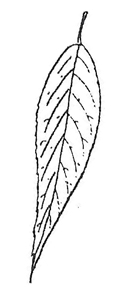Salix amygdaloides (sa’-liks a-mig-da-loy’-dez)
Family: Salicaceae, Willow
Key Steps
- 1b – Alternate leaf arrangement — go to 18
- 18a – Leaf simple — go to 19
- 19b – Thornless — go to 22
- 22e – All leaves unlobed — go to 31
- 31c – Leaf is long and narrow (3-4 times longer than wide) — go to 37
- 37a – One bud scale — go to 38
- 38b – Branches not drooping, leaves ¾ to 1 ¼ inches wide — Peachleaf Willow
- 37a – One bud scale — go to 38
- 31c – Leaf is long and narrow (3-4 times longer than wide) — go to 37
- 22e – All leaves unlobed — go to 31
- 19b – Thornless — go to 22
- 18a – Leaf simple — go to 19
Description
 Leaf: 2-6 inches long, 1 inch wide. Broadest below the middle. Dark yellowish-green, whitened beneath. Very long pointed, fine toothed, leathery. May have small, kidney-shaped stipules. Petiole very slender, may be twisted, no glands. Leaf may have large, yellow, central vein.
Leaf: 2-6 inches long, 1 inch wide. Broadest below the middle. Dark yellowish-green, whitened beneath. Very long pointed, fine toothed, leathery. May have small, kidney-shaped stipules. Petiole very slender, may be twisted, no glands. Leaf may have large, yellow, central vein.
Bud: One bud scale. Egg shaped, shiny. Brown on top, light orange below. 1/8 inch long. Hugs stem. True terminal bud absent.
Leaf Scar: Narrow, nearly straight across. 3 bundle scars. Very small stipule scars.
Stem: Branches a little drooping. Shiny, yellow-orange or brown. Slender and smooth.
Bark: Blackish.
Pith: White, solid, small.
Flower: Yellow-green, hairy catkin, 1 inch long.
Fruit: Cottony capsule.
Habit: Not as weeping as Weeping Willow. Colorado native found along streambanks. 40-60 feet tall.
Culture: Moist conditions.
Resources




